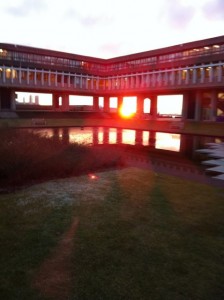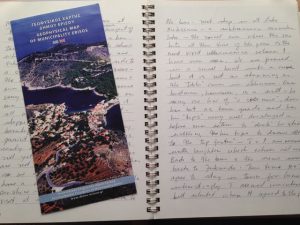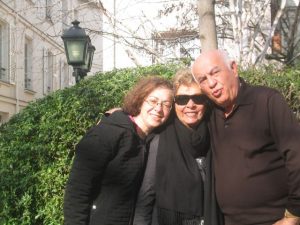Posts Tagged ‘time’
A Life In Script
I feel the absence of my mother most keenly when I catch a glimpse of her writing.
When I look at the carefully crafted words and sentences she moulded; the ones she wrote down. An alchemy of thought, energy, effort, pen, and paper.
Mom used writing to express her thanks. To scold political leaders. To extend congratulations. To advocate for causes. To nurture connections.
She cherished the handwritten note even after her grandsons helped her learn to use email.
My mother believed there was a personal quality to a handwritten note that was impossible to replicate in type form. I agree. Each stroke of the pen captures a person’s personality, their character, history, and experience. The way in which hand-written words create a web of meaning is the most affirmative statement of “I am here”. When I catch sight of my mother’s writing script I wonder how it is that she is not here.
How can the person whose heart propelled the pen across the page not be here to cross that t and dot that i?
I feel the absence of my mother most keenly when I see her writing, with an intake of breath and a vise clamped around my heart.
My mother’s script is from an earlier era when education had not been commodified and contorted. When it was a gift to learn. A time when writing was valued not only for its content but for its form. When penmanship spoke of culture and education and, yes, privilege.
That script, her unique cursive style, is undeniably and uniquely my mother, Yulanda.
I feel the absence of my mother most profoundly when I stare at her writing.
René Descartes said, “I am thinking, therefore I am.” My mother’s cursive script says, “I wrote, therefore I have been.” And as the ability to recall her physical presence becomes the dream of time lapsed, her writing will remain forever real and tangible.
As her daughters, her children, and perhaps someday her grandchildren and descendants, we will carry her DNA forward in time. However, her letters, the drafts of her speeches, the thank-you cards, her recipes, the quotations she noted down, her signature — like the one in the volume of William Shakespeare’s collected works that she used for her studies at McGill — these all serve as a testament to her personal spirit.
No other hand shaped those words, no other mind developed those ideas, no one else forged those connections: letter to letter, person to person, heart to heart.
I feel the absence of my mother most keenly when I catch a glimpse of her writing. The words and sentences that flowed from the pen she held, the pen she guided into forever.
In the year and months since my mother died (and a month before what would have been her 79th birthday), my family has cried, laughed, and celebrated birthdays, anniversaries, graduations, and weddings. We’ve attended funerals. We’ve had time at home, we’ve been away together and separately. Time has carried us forward. It is life’s imperative.
And she, my mother, has been there with us. In each moment, in each thought, in each word.
She always will be.
“If we danced more and sang more, we’d be happier people.”
Yulanda M. Faris
July 2, 1937 – April 23, 2015
Ruminating On Paths Taken And Not Taken
Today the BC Supreme Court released a decision which finds changes made to the collective agreement with teachers in British Columbia, specifically those around class size and composition, unconstitutional. In addition, the court awarded the British Columbia Teachers’ Federation (BCTF) $2 million in damages which the provincial government must now pay.
That’s what I should probably talk about today given my role in BC’s public education system, but there are too many unknowns at this point, including the government’s response, and I don’t have enough details for an informed comment.
Not that I have answers to the other topic which I’ve been pondering.
George Bernard Shaw famously said, “Youth is wasted on the young” and we often hear the phrase, “If I only knew then what I know now.”
In a similar vein, I’ve thought of this: there is no undo/redo.
Computer programs have undo/redo, commands that allow us to zip back and forth in our work or our game to the point before we made an error or made a choice which we no longer support or chose a path which has not led us to the desired outcome.
In life, however, there is no undo/redo. As much as people advocate for a philosophy of “no regrets” I think that’s simplistic and difficult to apply in our own lives.
Why?
Because if we are honest with ourselves, there are regrets. We recognize points along the way where we made choices which were not good ones or decisions which didn’t play out the way we hoped they might or where we passed up an opportunity which, with hindsight, we think may have worked out better although there’s never any guarantee it would have.
I also think the idea of living in the moment, while it has merits, is not the answer either because we are not creatures of the moment: we have a past that has shaped us and we have a future which beguiles us.
The question becomes how to reconcile ourselves with our choices and with their outcomes.
It’s difficult to do when we hit those bumps in the road where each and every decision is up for evaluation. Where the “what-if” game becomes the one haunting us in the present. Where our confidence and our understanding of who we are takes on the metaphorical aspect of a cannibal rat ghost ship.
And we’re lucky if we find our way before circumstances intervene to make a situation worse or to take the journey along life’s path out of our control.
And while there is no undo/redo, there is try which puts me at odds with Yoda, the Jedi Master in Star Wars. With deference to the green sage, sometimes all we can count on is try.
Because without try, there is no possibility of change.
And change, according to ancient philosophies, is the only constant.
Time May Not Care But I Do
December looms. The last month of the year. I can only wonder how it is that 2013 has just over four weeks to go.
The months have flown by, the year has evaporated. Like the contrails of planes which soar overhead, all that’s left are lingering impressions of passing through space and time. I know I started there and I know I’ve ended up here, but I’ve lost the texture of the days and won’t remember all the details of my experiences along the way.
Time’s not going to hesitate in its relentless march to give me back the days or weeks or minutes or seconds I wasn’t able to enjoy or forgot to savour.
Time doesn’t care, but I do.
Why?
 Because the end of the year means the end of the semester at Simon Fraser University (SFU) and while time may not care that it’s left me breathless with its bruising speed, I do care about having to say goodbye to the students I’ve been working with since the first week in September.
Because the end of the year means the end of the semester at Simon Fraser University (SFU) and while time may not care that it’s left me breathless with its bruising speed, I do care about having to say goodbye to the students I’ve been working with since the first week in September.
There are any number of reasons for me to be ecstatic. Once exams are over and grading is done, I won’t have to contend with the agony of marking. Once the last book has been read and the last office hour held, I may be able to reintroduce balance in my day to day activities. Once the demands have lessened, I might be able to capitalize on a few extra hours of sleep.
I have many reasons to celebrate. But here’s the thing. All of those reasons and more are trumped by this one truth: I treasure working with undergraduates even if they hand in papers late, even if they won’t contribute to a class discussion, even if they haven’t done the reading, even if their writing skills are still in development, and even if they don’t care as much about the course as I do.
Based on concentrated interactions over 12 to 13 weeks, even if it’s just for 50 minutes each week, a connection is established although not with every student and not always successfully. A rapport grows among the members of each tutorial group, a sense of common purpose.
And for me the most rewarding moments are those times during a tutorial session when I can actually see the students thinking. When it seems like they are puzzling over a new idea, a new concept. Of course, they may just be squinting at the clock in anticipation of being released from the torture of sitting in yet another classroom with yet another TA droning on about something or the other. Maybe. But more often than not, I feel they’re giving serious consideration to the material at hand. They are learning and their horizons are expanding.
My time with these students is rapidly coming to an end and I’m incredibly appreciative of the time I’ve been privileged to spend in their company.
It may be brief, it may be over all too soon, but it’s time well-spent.
The Speed of Life
Math was not my favourite subject in high school, but I was proficient with the material presented. Decades later a modicum of what I learned is hardwired for my general use, but don’t ask me to explain an advanced concept and please save me from anything that has to do with calculating probabilities.
One formula that has stuck with me is d = rt or distance (d) equals the rate of travel (r) multiplied by time (t). And while familiarity with the relationship between these three factors comes in handy for planning, lately I’ve been thinking about the formula’s applicability in a different way.
Why?
Because I think the distance we travel daily contributes to the feeling we have that life is hurtling by us at breakneck speeds.
On days when I teach, for example, the 25 kilometre journey to SFU’s Burnaby campus takes me about thirty minutes each way if traffic is flowing smoothly. That’s nothing compared to those who may commute in to Vancouver from the Fraser Valley or drive down each day from Squamish or ferry over from the Sunshine Coast.
Compare that to the daily distance my Grandmothers would have travelled as young women, my paternal Grandmother in rural Lebanon and my maternal Grandmother in rural Jamaica. Until they married, their circle of travel likely extended no further than 10 kilometres, by foot, over the course of a day.
We have extended the distances we travel dramatically and not just for essentials. How many consider a drive to the Bellis Fair Mall, a three-hour roundtrip from the Lower Mainland depending on border waits, a simple excursion? Or consider how cavalier we have become about booking vacations requiring hours if not days of travel?
So if the distances we traverse have become more extensive, and if you accept that our time is fixed (not just in the sense of 24 hours a day, but in the finite sense of our mortality), it would seem that the factor which has changed the most with regard to our day-to-day is r, the rate.
And that may help explain why it feels like we are living at a faster and faster rate, one which increases with each passing year.
Is it any surprise then, as we’re preparing to celebrate the arrival of the new year, that many of us wonder what happened to the old one? How is it that we are celebrating graduations when it seems like just yesterday we were celebrating the births of the children in our families?
And nothing drives home the finite nature of time as much as the loss of those around us, whether people we’ve known and loved, young and old, or strangers from far away whose images fill the news.
That’s why it’s vital to recognize, sooner rather than later, in our instantaneous 140-character world, that we do not have another now.
And unless we take control of the speed of our life, it will pass by in a blur.



